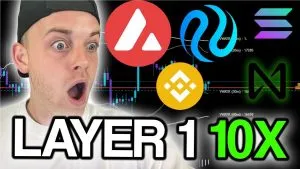The rapidly changing world of blockchain, once led by Ethereum, is now seeing new Layer 1 blockchains emerge, each with unique advantages, and having a mix of assets is critical to long-term success.
Ethereum struggles with scalability and high fees, which has led to the rise of alternative Layer 1 networks. These new blockchains often offer faster speeds, lower costs, and special features that meet different needs in the blockchain space.
Instead of one main platform, the future will likely include many specialized blockchains driven by the increasing complexity of blockchain applications and the demand for customized solutions.
As the blockchain space rapidly evolves, it’s important to keep an eye out for promising new networks. Here are five Layer 1 blockchains that could make big moves soon.
Injection
Injective, a new layer-1 blockchain in the Cosmos ecosystem, has quickly attracted attention for its innovative features and solid performance. As an interoperable platform, it connects Ethereum-based assets and expands their potential for DeFi applications.
Based on its ecosystem, Hub Injective allows users to participate in DeFi activities such as token swaps, staking, and governance. This decentralized platform is powered by the original Layer-1 token, facilitating its economic development.
Injective excels at key blockchain metrics such as block size, block time, processing speed, and finality. These advantages reduce latency and increase responsiveness, making it ideal for high-frequency trading applications.
Injective is advancing blockchain technology with features such as real-world asset tokenization and frequent batch auctions, strengthening its position in MEV resistance and providing a more secure network.
Their commitment to gas compression efficiency ensures the lowest Layer 1 transaction fees in the industry.
Near
Near Protocol, an advanced Layer 1 blockchain, stands out for its stability and high performance. As the first carbon-neutral Layer 1 blockchain, it is a pioneer in the environmentally conscious blockchain space.
Focusing on speed, low transaction fees, and climate neutrality goals, Near meets the growing demand for sustainable blockchain technologies. Its role in carbon pricing underscores its importance in climate-focused blockchain initiatives.
Offering up to 100,000 transactions per second, Near significantly outperforms Ethereum in terms of scalability. Low transaction costs also make it a good choice for developers and users looking for efficiency in blockchain platforms.
NEAR prioritizes developer experience by supporting multiple programming languages and tools, such as NEAR Studio, streamlining the creation and deployment of decentralized applications (dApps).
With synchronization tools like Rainbow Bridge, Near facilitates cross-chain transfers, improves accessibility, and expands its interoperability potential with other blockchain networks.
Avalanche
Avalanche, a future-proof, developer-friendly Layer 1 blockchain protocol, launched in 2020. Designed for speed, versatility, security, availability, and accessibility, it processes up to 4,500 transactions per second with instant transaction times.
The original token, AVAX, provides transaction fees, network security, and serves as a unit of account in the Avalanche ecosystem. Avalanche, as an open-source project, provides a high-performance network that balances speed, cost-effectiveness, ease of use, and decentralization.
Earning AVAX is the key to paying transaction fees, interacting with smart contracts, and earning rewards on the network.
AVAX has significant potential, especially as DeFi and dApps continue to grow on the Avalanche network. With a market cap of around $8.7 billion, AVAX remains undervalued relative to its growth potential. As blockchain adoption grows, Avalanche could see significant gains.
BNB chain
BNB Chain is among the largest blockchains in terms of transaction volume and daily active users. It was created in 2022 through the merger of Binance Smart Chain and Binance Chain and operates as a community-based, open-source, and decentralized ecosystem.
Maintaining compatibility with the Ethereum Virtual Machine, BNB Chain utilizes robust consensus mechanisms and functions as a multi-chain hub. With a market cap of $40.9 billion (excluding stablecoins), the native token, BNB, is the third-largest, highlighting the power of the BNB Chain ecosystem.
By attracting developers and projects, BNB remains a key player in the cryptocurrency landscape. After reaching an all-time high of around $710, analysts see further upside potential and predict that BNB could reach $1,500 in the next bull run, offering a strong investment opportunity.
Annually
Solana, a highly scalable Layer 1 blockchain designed for mass adoption, was founded in 2017 as an open-source project by Solana Labs with support from the Solana Foundation.
Compared to competitors like Ethereum, known for its high transaction speed and lower fees, Solana has emerged as an ideal choice for meme coin projects.
Currently valued at $130 per coin and with a market cap of $60 billion, Solana shows significant growth potential. Its price rose above $200 in March, indicating that it may be low enough. As more people enter the cryptocurrency market and the meme coin sector expands, Solana’s popularity is expected to grow even further.
Conclusion
These five Layer 1 blockchains provide a solid foundation for any cryptocurrency portfolio. Each of them has their own strengths and benefits that make them promising for development and investment.
Active development is pushing these blockchains forward in technology. They solve problems and add new features that help them adapt to market needs and remain competitive.
As blockchain technology gains traction in industries such as finance and supply chain management, these networks will become more valuable. Growing recognition of blockchain’s benefits is likely to increase demand for these key platforms.
Their key strengths (such as scalability, security, and developer-friendliness) set them up for future growth. Their ability to handle large transaction volumes, maintain strong security, and attract developers to build new applications are critical factors for their long-term success.
Investing in these Layer 1 blockchains gives you access to the growing blockchain ecosystem. These foundational networks will play a major role in the future of decentralized technologies and provide significant opportunities for growth and increased value.
If you are interested in exploring other possibilities, consider Pepe Unchained. Although currently in pre-sale, it is a project that is developing its own Layer-2 blockchain. Pepe Unchained aims to reduce transaction costs, provide high speed, and improve efficiency.
Pepe Unchained is more than just a commemorative coin; it is an important project aimed at improving Pepe’s functionality and solving scalability issues for its investors. To participate in the $PEPU token pre-sale, please visit pepeunchained.com.






